From The Strand Magazine, December 1903. Illustrated by Laurence Davis (art) and Elliott & Fry (photographers)
The English House of the Future.
VIEWS OF LEADING ARCHITECTS.
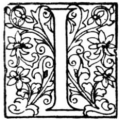 N a recent number of THE STRAND MAGAZINE Mr. Marcus Stone, R.A., uttered a passionate complaint against the present condition and tendencies of early Twentieth Century architecture in England, which surprised a great many people. Although we live in an age when nearly every head of a family, however humble, is either building or planning to build his own dwelling, when popular interest in architectural matters is increasing by leaps and bounds, yet somehow it seemed to be taken for granted that everything was going on all right, and that what with beautiful red - brick flats, Queen Anne villas, and stone-fronted theatres and shops, we could hold our heads as high as any of our Continental neighbours. But it appears we were all wrong. We have no style—no national architecture, such as France and Germany and Italy have—and, worse still, there is little prospect of our having any. We had a style, but it was a couple of hundred years ago, and it died with Queen Anne. Since that period we have been floundering about, each man for himself—now Italian, now Greek, now a bastard Gothic, now Renaissance, then back to Queen Anne again. This, according to certain distinguished Royal Academicians, who
write to THE STRAND, is "nothing less than forgery," "the mere reproduction of the work of a former period," and consequently "valueless."
N a recent number of THE STRAND MAGAZINE Mr. Marcus Stone, R.A., uttered a passionate complaint against the present condition and tendencies of early Twentieth Century architecture in England, which surprised a great many people. Although we live in an age when nearly every head of a family, however humble, is either building or planning to build his own dwelling, when popular interest in architectural matters is increasing by leaps and bounds, yet somehow it seemed to be taken for granted that everything was going on all right, and that what with beautiful red - brick flats, Queen Anne villas, and stone-fronted theatres and shops, we could hold our heads as high as any of our Continental neighbours. But it appears we were all wrong. We have no style—no national architecture, such as France and Germany and Italy have—and, worse still, there is little prospect of our having any. We had a style, but it was a couple of hundred years ago, and it died with Queen Anne. Since that period we have been floundering about, each man for himself—now Italian, now Greek, now a bastard Gothic, now Renaissance, then back to Queen Anne again. This, according to certain distinguished Royal Academicians, who
write to THE STRAND, is "nothing less than forgery," "the mere reproduction of the work of a former period," and consequently "valueless."
All this naturally begets the question, What will the architecture—what will the English houses of the future—be like? To no one could we more fitly apply—for no one could speak with clearer authority—than the most distinguished living architects of Britain, such men as Norman Shaw, R.A., G. F. Bodley, R.A., T. G. Jackson, R.A., Aston Webb, R.A., and others. It is admitted that a classic or a Gothic revival may yet alter the whole face of London. Or is the coming century likely to produce a distinctively English type of architecture ? To such a question Mr. Norman Shaw responds unhesitatingly :—

"No. 'Nothing begets nothing.' It would be just as reasonable to suppose that a living man could be evolved from a corpse as to suppose that a living style of architecture could be evolved from a dead one, or any number of dead ones. Architecture is nothing if it is not a living art; reproductions are not merely valueless, they are misleading.
"Your readers must not run away with the idea that architects are to blame for this very unhappy state of things. It is in no way their fault; it is their misfortune, and a very grave disaster for the community generally. Amongst architects there are, and have been during the last hundred years, many men of great ability, some rising to genius; but unhappily these men, instead of carrying on an old tradition and developing new phases of their art (which might in many cases have resulted in the creation of a new style), have had to spend their lives in making reproductions of old and worn-out styles—first Greek, then Gothic, and lastly, so-called Queen Anne. Many of their works have great artistic excellence, but unhappily they are in no way examples of living art; in other words, they are mere fashions. Greek architecture was studied with enthusiasm and practised with great skill, but in a short time it was thrown to the winds, and Gothic almost alone held the field; and it, in its turn, was discarded in favour of Queen Anne. Three widely different styles in one century—all studied carefully, and practised with very great knowledge and ability, on which countless millions have been expended, and admittedly with no result so far as concerns the evolution of a truly representative national style.
"Some forty or fifty years ago there was much talk of the coming of a new style, worthy of the age; 'Victorian' was to be its name, but it never got farther than talk. The utter impossibility of inventing a new style soon became apparent even to its warmest advocates, and the talk died out.
"There is no analogy whatever between the French and ourselves. They preserved an unbroken tradition from the tenth century practically up to the present day (though the appearances of l'Art Nouveau' makes us all tremble for their future). During much of the last century, whilst our best men were reproducing old work, their architects were developing and adding to their existing style on traditional lines, with the result that many of their works are as truly great and refined as the best old Greek work, with the immense advantage that they are absolutely modern, and at the same time entirely French in character.
"You ask, 'Will not future urban conditions gradually contribute to a revolution in the forms and fabric of the houses?' Candidly, I see no signs of such a change, nor can I see why there should be. There may be doubtless changes of fashion. Fifty years ago houses were mostly cemented over, and had large plate-glass windows. Now they are mostly of red brick with mullions and lead lattice glazing. Some thirty or thirty-five years ago my clients used openly to curse me for proposing lead lattice; now, people do not seem to be able to get enough, and use sash-bars, lead lights, and plate-glass all in the same window! But that does not point to a distinctively English type of architecture. It is only a change of taste, a fashion, a loose way of doing things, and bad art—in no way can it rank higher than the average dressmaker.
"A Fine Arts Minister is all nonsense at the present time when every man—be he architect, painter, or sculptor—is a law unto himself. In architecture, when all styles are practised, how are you to secure 'harmony and unity'? What harmony and unity can there be between 'Georgian' and the style of the new Roman Catholic Cathedral in Westminster, and how is a Fine Arts Minister to regulate this? And should severe Greek reappear, which is not improbable, there would be still less harmony." A return to "severe Greek"—say, in Ludgate Hill, as our artist has depicted—would certainly startle the intelligent foreigner.
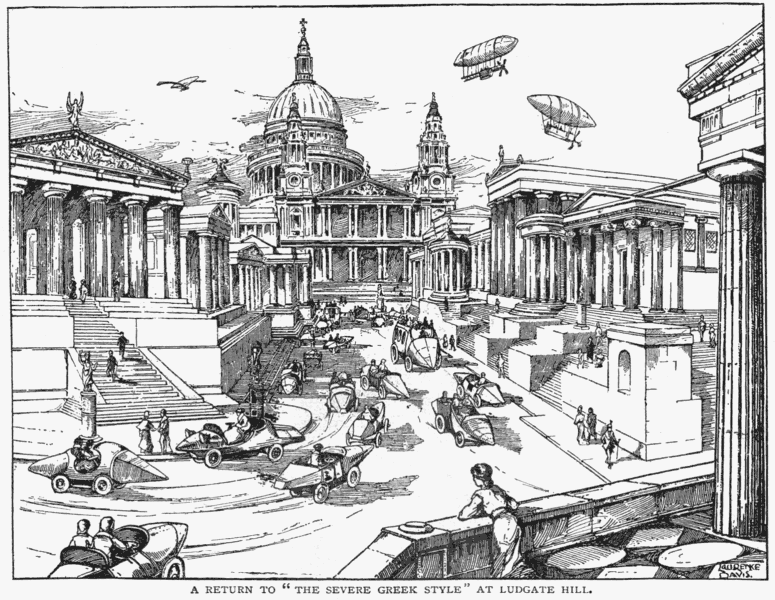
It will be seen that Mr. Norman Shaw is a pessimist as regards the " Edwardian " house. Let us turn to the views of Mr. Jackson, R.A., which are slightly more hopeful, and will certainly be read with deep interest.
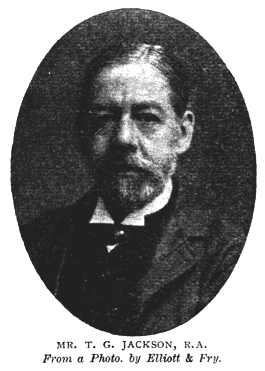
"Your question whether a distinctly British style of architecture is in process of evolution is one rather for the critic or historian than for the working artist.
"If such a process of evolution is really going on it should be regarded rather as accidental than essential. Certainly its progress cannot be hastened by attention, though it may be retarded. We must not pull the plant up to see how it is growing. New styles of art, when they come, come not with observation. For the worker in any branch of art the introspection habit is not wholesome. Our aim should be to do what we believe in ourselves, never minding whether it be novel or not, for that is a matter with which we have nothing to do. If art is pursued conscientiously and if the artist puts himself into what he does, his work will live, and will have originality in the best sense of the word, though not in the sense of those who clamour for a new style as if it could be invented like a new machine.
"Premising this, I may say that though the greater part of what we do is either on the one hand directly imitative of bygone styles, or on the other aggressively bizarre — the latter, especially in our commercial architecture, resulting in buildings perhaps the basest the world has ever seen—still there is a fair proportion of sober, sensible, restrained architecture springing up around us, which has a character of its own, and may hereafter be regarded as typical of our day at its best.
"That this, however, should settle down into one general and universally accepted style, marked off from all others like those which succeeded one another from the eleventh to the seventeenth century, is not, in my opinion, to be looked for. The art of the future, in every one of its branches, will, I believe, be strongly individual, though no doubt it will and must, if it is to live, be coloured by the circumstances and conditions of the age, which will give it an element of consistency."

Mr. John Belcher, A. R.A., writes as follows: "Although art is cosmopolitan, architecture, like the sister arts, necessarily partakes of national and individual characteristics. With nations as with individuals there is a period of infancy which may be regarded as the primitive and experimental stage. This merges into youth, with its restless energy and lively imagination, passing on to a period of manhood in which may be expected strength and dignity with becoming restraint.
"In each cycle, as in the life of individuals, there is apt to follow a time of decrepitude or decadence. This also has been the history of each of the 'periods' or so-called 'styles' in architecture, not only in this country but in every other.
"Architecture is, or should be, a living art, giving expression to the thoughts and sentiments, the methods and aspirations of the day. The mere reproduction of the work of a former period—which told its special story — is nothing less than forgery, and is of no value or interest other than historically. Where there is life there must be development, not the mere copying of any past 'style' or type of architecture.
"In England there has always been a distinct national type, whether the style be Gothic or classic in origin. So much for architecture per se, but when the architecture of cities is compared, as for instance that of London and Paris, another point must be taken into consideration—here such a comparison is rather one of method and no method, and the subsequent result—than of the art itself.
"If, after the 'Great Fire,' London had been laid out as planned by Sir Christopher Wren, neither Paris, Berlin, nor Vienna—all good examples of municipal work—would have exceeded it in beauty. However, with the Englishman's love of freedom and liberty, all control was resented. Each man sought to do what seemed best in his own eyes, quite regardless of the community at large; whereas in Paris (as elsewhere) there has been a Minister of Fine Arts, who has controlled the setting out of streets untrammelled by financial considerations, and who has seen that the designs of the buildings to be erected will harmonize with the surroundings and balance with the general scheme. Thus the speculating builder with his extravagant vulgarity has been repressed, and architects have been employed and encouraged to do their best.
"If our cities are to be improved and our architecture developed there is need of such an authority who would insist upon a high standard of architecture, especially in our principal thoroughfares. A well-balanced order, good vistas with effective terminations such as Wren suggested, would in due course be obtained. The demand for something entirely new and the consequent struggle to be original is fatal to the development of good architecture, which in my opinion should be a living art of steady growth."
But this demand for a Minister of Fine Arts is not echoed by Mr. R. Phene Spiers, who writes: " I do not think the appointment of such a Minister to control urban building desirable. Art cannot be confounded with politics."
Mr. Aston Webb, R.A., the distinguished architect to whom has been entrusted the great task of preparing the National Memorial to Queen Victoria, thus expresses his convictions on the subject of a new and distinctively British type of architecture:-
"If by your inquiry is meant whether some entirely new type of architecture is a probability of the near future, I have no hesitation in saying that I do not think so. Types of architecture are not so much typical of a single country as of the civilized world, and all history shows a gradual development of types occurring in various countries simultaneously, a lead being taken sometimes by one, sometimes by another, largely influenced, perhaps, by its prosperity or by the appearance of an individual genius; but there is a variation of style in these types which makes each distinctive of its country. Thus in England in mediæval times Gothic architecture developed into what we call the Perpendicular style, entirely distinctive of this country. In the Renaissance period an entirely distinctive style was developed by Inigo Jones, Christopher Wren, and their school, and so again in the Georgian period.
"Then came a period of arrested progress, of looking backward and a critical examination of what had gone before, though even in this period one of our greatest buildings, the Houses of Parliament, was produced, and tradition was not wholly lost; and now, again, there is increased activity and progress which will probably be greater in the near future, for there are a large number of able young men coming forward who are working, at any rate, on parallel lines and undisturbed by the strips and shibboleths of style so misleading and mischievous to a previous generation.
"Personally I have far too high an appreciation of the work of my contemporaries to take the pessimistic view of our art that is taken by some. We architects, like other artists, are free in the criticism of each other's works, and though this does not necessarily imply a want of sympathy with them, it undoubtedly gives that impression to the public, who not unnaturally take our work at our own valuation, and in addition credit us with much of the degrading building to be found in and around all our towns, and with which, of course, architects have in reality nothing whatever to do.
"But if we take the best architecture of the present day we can surely see clearly a style developing which is distinctive of this country. Our domestic architecture inspired by Mr. Norman Shaw and continued by many able followers is distinctive, and greatly in advance, I venture to think, of any other country at the present day. So with our schools, hospitals, and municipal buildings, great progress has been made both in their design and planning. What, for instance, could be more distinctive than the series of Board schools erected in the early days of the London School Board, and which formed a type for similar buildings throughout the country? Again, what country can show a nobler series of modern churches than those erected, say, by Pearson, Butterfield, Sedding, Bentley, and others still with us? More unity we certainly might and ought to have, but no amount of writing will bring this about, though everything that tends to an increased intelligent public interest in architecture will greatly help it. It is a strange fact that, though architecture is the art of all others that most nearly concerns the public, it is the one art about which the public shows the least concern.
"The pride of citizenship shown in the improvement and beautifying of our cities, though probably increasing, is not conspicuous at the present day, and, though our municipalities are awakening to the importance of it, there does not seem sufficient public interest to enable them to carry their schemes to maturity, and so we see great schemes produced only to be laid aside or carried through in an incomplete, commercial, and half-hearted way, without unity and without efficient control.
"Architects are endeavouring to do their part by organizing a more complete system of architectural education which may do much to give increased unity to our British architecture, and when this is fully developed and aided by the State, the Municipality, the Royal Academy as the head of all the arts, and public interest increased by an intelligent and discriminating Press, we may hope to see a still further development of a distinctively national style."
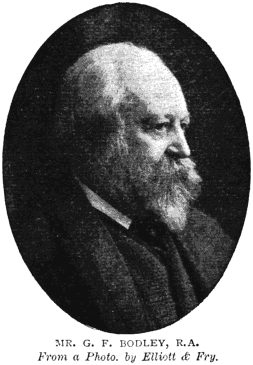
Mr. G. F. Bodley, R.A., writes to THE STRAND: " There can be no doubt that the houses we dwell in, and the houses and the public buildings we see around us, must have an influence for good or for evil, for pleasure or for distress, on our lives. That there should be a dignity and a suavity about public buildings, and a pleasant character given to our houses, will be allowed by all. But these expressions are not too frequently attained nowadays. At the present moment it is not at all, I venture to think, a question of one 'style' or manner of building. It is a question of the everlasting principles of beauty, the obvious principle of fitness, and, negatively, the absence of ugliness and a vulgar extravagance of manner.
"Let us at once put aside and dismiss from our minds all ideas of the invention of a new style. All the great styles of architecture have been founded one on the other. None have been of mushroom growth. Theremust be no foolish striving after originality for its own sake. It is design—it is what an architect may have to tell the world of beauty, of grandeur, of fitness, that makes a fine building. It is the spirit—the animus—that ennobles, or should ennoble, every building.
"That there is a striving after better things in architectural art is happily evident, and good work has been done.
"But as regards the questions to which an answer is requested, I would say that I see no signs of the birth of a new style that is likely to become at all general. At the present moment I think artistic minds would shrink from any prevalent manner of architecture becoming general. It is 'not good enough.' We must wait for days not only of more art, but of greater unity of feeling. Meanwhile, each architect must do his best, in whatever style he may work, to make his buildings dignified and beautiful — to give them character, and to avoid eccentricities and an extravagant manner. In one word, to have noble conceptions, worked out with refined and delightful detail.
"With regard to the question of the crowded traffic in London streets, I believe the best solution would be, as we see at Chester, to have the shop windows raised a story. Their visitors would then be on a different gangway to the main pavement. How far this would suit the views of the shopkeeper I cannot tell.
"Concerning the question of 'sky-scrapers,' their offending element is that they destroy the scale of humbler but yet, it may be, more dignified buildings.
"There may be a glimmer of a dawn for more artistic days for architecture. But the sun has not yet risen very high. We have much to learn as to what to achieve and what to avoid. The hopeful thing is that men's minds are turned to the subject—that of having more delightful houses and more noble public buildings."
Mr. Reginald Blomfield writes: "It seems to me that for the last one hundred years we have had no distinctively English type of architecture owing to the fashion for archeological revivals. There is evidence of growing impatience with these revivals, and of a tendency to swing back to the less exuberant forms of classic. But the effort is sporadic, and the problem is to pull these various tendencies together. I think it possible that a new type may evolve itself out of the actual parts of construction, expressing itself, not in what is called 'free classic,' which is usually a stalking-horse for incompetence, but in what we may call rationalized classic.
"As to a Ministry of Fine Arts, there seems to be a growing need of some such authority. Things could not be very much worse than they are already in England in this regard, and an efficient constitutional authority might straighten matters out, but the absorbing interests of politics and business prevent the arts from receiving serious attention in this country, and it seems improbable that any English statesman would ever trouble his head about the matter."
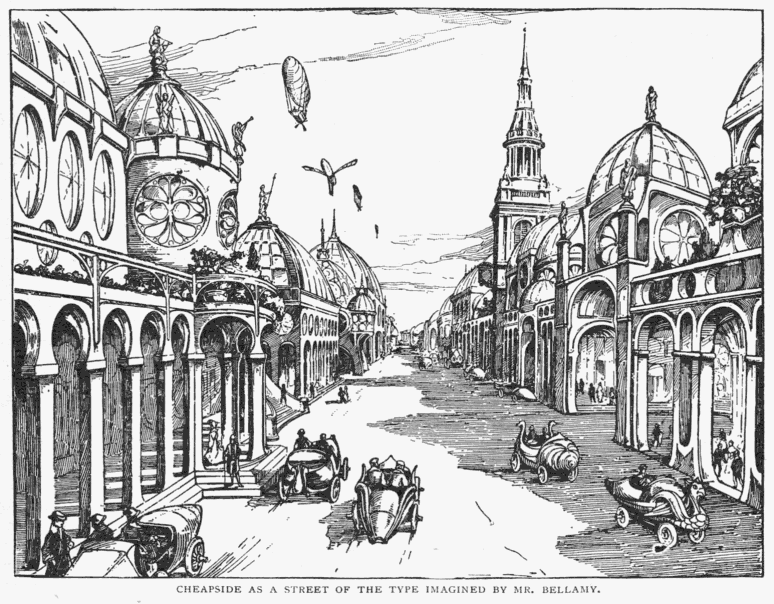
And now we turn from the practitioners to the prophets. Some twelve years ago, Mr. Edward Bellamy, the author of " Looking Backward," declared that in his opinion " the houses of the future," i.e., the year 2000, " whether in England or America, would be far better adapted to the needs and conditions not of their occupants alone, but of the community at large. With the extension of facilities for rapid and cheap locomotion land values in the cities will fall, so that it will become possible to erect large and beautiful buildings whose proportions will not be cramped by squalid, treeless streets, nor dwarfed by 'sky-scrapers.' Glass and other transparent material will be employed in the roofs, and the public will be safeguarded against the vagaries of the weather by extensive arcades and colonnades. . . . The low-ceiled room and the grim rectangular window will disappear." Our artist has here endeavoured to transform Cheapside into a street of the Bellamy type, with circular windows and colonnade, which bid defiance to the weather. It will be remembered that in "Looking Backward " Mr. Bellamy touches lightly on the aspect of the city of a hundred years hence. Yet compare his description with that of Mr. J. K. Jerome describing a typical London street of today: "A long, straight, brick-built street — one of those lifeless streets made of two drab walls upon which the level lines, formed by the precisely even window-sills and doorsteps, stretch in weary perspective from end to end, suggesting petrified diagrams proving problems."
Surely the future will correct such ugliness —only too characteristic—as that. Into that future none, perhaps, now living has dipped so persistently—or so entertainingly—as Mr. H. G. Wells.
The following "Anticipation" Mr. Wells has specially written for this number of THE STRAND MAGAZINE:—

"The contemporary architect presents to an extreme degree the universal trouble of to-day. His, more than any other profession, was a traditional one; all the conditions seemed established for ever, and all a man had to do was to select, to refine, to study exhaustively, and then, most tentatively and if he could, to improve. A new character in the capital of a pillar, a new proportion between this measurement in the inevitable temple and that, marked a new order in architecture. The architecture of Greece and Rome, the Gothic cathedral, grew through long centuries almost as slowly as crystals and to a kindred perfection. In the timber houses of Switzerland and the timber houses, the tiled and thatched house, and the stone and brick mansions of our own country up to the eighteenth century there is the same secular ripening, each feature worked over and thought over by a long succession of builders, each innovation chastened and incorporated. And then suddenly came this present period of violent novelty, of social and intellectual disorganization and reorganization, of new materials, new methods, new needs, and universal crudity. For the stone, the brick, the familiar timber of tradition, the modern architect has a hundred untried materials: iron, steel, artificial and glazed bricks of unprecedented possibilities, new woods from the uttermost parts of the earth, new appliances that make a thousand things possible to-day that were beyond hope of a miracle to his Georgian predecessor. Within, plumbing, new means of lighting, new means of communication between one part of a building and another, lifts and the like have revolutionized all the conditions of convenient arrangement; while without, a building which had formerly to be beautiful only when lit from above in sunlight and moonlight, is now in nine cases out of ten urban, and must be viewed from much nearer at hand than were the old buildings, and most often by strong artificial light from below. Yet tradition is so strong in architecture that if a band of ornament were run across the front of a theatre immediately below a deep projection, no mere ocular evidence would dissuade the critic from condemning this as being lost in shadow.
"In spite of such vile exploits as the National Liberal Club or that terrible mixture of mediævalism and machinery, the Tower Bridge, I do not think that the contemporary architect has any reason to be ashamed of himself. He has to solve problems infinitely more complex and difficult than those of his predecessors; there is no comparison in difficulty between a Greek temple and a modern hotel of fifteen stories giving on a forty-yard street. He works not only under the burthen of a powerful professional tradition entirely incompatible with modern requirements, but in the face of an unimaginative public hostile to real novelty and amenable only to the grandiose. Perhaps he attains beauty but rarely—it is astonishing he should ever attain beauty at all—but he does contrive very often to be inoffensive and often to be dignified and sane; and I believe it depends much more upon the public than upon this profession how soon domestic architecture, at any rate, will break away from the muddle of styles and reminiscences in which it is lost at present towards first a distinctive and then, as the true artists get well to work, a beautiful Twentieth Century Style.
"The Twentieth Century house, when it is thoroughly worked out, will be very different in character from the houses of any former period. For example, it is very doubtful whether it will have chimneys. It seems highly probable that electric heating will supersede the coal fire, and in that case not only will the chimney-stack and the blackened and blackening chimney-pots go, but also the internal grouping of the room about the fireplace; instead there will he a heater in the centre of the apartment. At present electric heaters appear to be designed by ironmongers' apprentices in their spare moments, but there is no reason why an electric heater should not be made a very gracious and beautiful thing. Moreover, the air in rooms will be spun out by an electric fan and will come in through a proper shaft and filter, and these appliances not only afford scope for the designer and metal-worker, and the emergence of the air-shaft upon the roof an architectural feature, but they release the windows from the task of ventilation. The architect will no longer be tied to the hygienic sash-window nor obliged to keep the tops of his windows close to the ceiling level; he will place them entirely for lighting and for beauty of internal and external effect. He will be able to make them to open or not as he wishes, and so he will be able to put them in many corners where now he dare not do so because of the risk of a draught. He will be tied to no particular shape, a liberty he will have to use with discretion. Moreover, with the supersession of coal fires the roof and exterior of a house will become possible resorts, and the town house where garden ground is limited will open out skyward with loggias and roof gardens.
"The trend of things seems all against any diminution of what is called the servant difficulty to-day, and, as a consequence of that we may expect the Twentieth Century house, not only to be full of labour-saving appliances, dustless sweepers, self-making beds, neatly-mounted electric cooking things, and so on, but built with a much more earnest regard toconvenience and cleanliness than our houses of to-day. There is a great advantage in curved lines, more especially at the corners of rooms and windows and where the wall meets the floor, if only because they prevent the accumulation of dust; and there is no reason why that abandonment of purely rectangular structure, which began and stopped short so long ago, with the coming of the arch, should not find a fresh impetus in the ease and economy with which corner shapes, curved slabs of artificial stone, and the like can be hewed out with modern machinery. And a third element one may reasonably count upon in a forecast of the Twentieth Century Style will be the substitution of light, hollow sound-proof walls built up of tubing and various artificial plasters and of strong, light metal frameworks for the common structural materials of to-day, and of close-fitting, metal-framed doors, of artificial stone floors with linoleum surfaces, and of a general use of fire-proofing devices. A house which is built in the spirit we have here forecast may very well be a beautiful thing, but with a lighter and less familiar beauty than the contemporary house. It will be of a slenderer strength, open and easy, and in its early days and for all its real Warmth and convenience it will look but a summer pavilion beside the houses of to-day. It will seem, in particular, to wear its unchimneyed roof with a flighty air. But in the end our present houses may come to be thought singularly squat, massive, and dark beside these elegant new corners.
"One writes 'house' and 'home,' but it is open to question whether in the inner urban areas, at any rate, the building which harbours a single household will not become a rare luxury, and the common work of an architect be to design a wide forest of buildings in which many families may live, and which will contain a common restaurant and trattoria, sending food up by the lifts if required, a common children's playground on the roof, and a common infants' school, club apartments, and the like. The scope for ingenuity and for invention in planning such places is enormous; it is work not only likely to be very profitable to an able as well as imaginative man, but likely also to be of the utmost service to the cause of human progress. It must be a good thing to be a good architect or a good builder, and to grow older with the sense of multiplying good houses in the world. It is given to few of us to know our work of such unquestionable benefit."
Special thanks to Roger Todd for finding and scanning this article - Marcus L. Rowland
 N a recent number of THE STRAND MAGAZINE Mr. Marcus Stone, R.A., uttered a passionate complaint against the present condition and tendencies of early Twentieth Century architecture in England, which surprised a great many people. Although we live in an age when nearly every head of a family, however humble, is either building or planning to build his own dwelling, when popular interest in architectural matters is increasing by leaps and bounds, yet somehow it seemed to be taken for granted that everything was going on all right, and that what with beautiful red - brick flats, Queen Anne villas, and stone-fronted theatres and shops, we could hold our heads as high as any of our Continental neighbours. But it appears we were all wrong. We have no style—no national architecture, such as France and Germany and Italy have—and, worse still, there is little prospect of our having any. We had a style, but it was a couple of hundred years ago, and it died with Queen Anne. Since that period we have been floundering about, each man for himself—now Italian, now Greek, now a bastard Gothic, now Renaissance, then back to Queen Anne again. This, according to certain distinguished Royal Academicians, who
write to THE STRAND, is "nothing less than forgery," "the mere reproduction of the work of a former period," and consequently "valueless."
N a recent number of THE STRAND MAGAZINE Mr. Marcus Stone, R.A., uttered a passionate complaint against the present condition and tendencies of early Twentieth Century architecture in England, which surprised a great many people. Although we live in an age when nearly every head of a family, however humble, is either building or planning to build his own dwelling, when popular interest in architectural matters is increasing by leaps and bounds, yet somehow it seemed to be taken for granted that everything was going on all right, and that what with beautiful red - brick flats, Queen Anne villas, and stone-fronted theatres and shops, we could hold our heads as high as any of our Continental neighbours. But it appears we were all wrong. We have no style—no national architecture, such as France and Germany and Italy have—and, worse still, there is little prospect of our having any. We had a style, but it was a couple of hundred years ago, and it died with Queen Anne. Since that period we have been floundering about, each man for himself—now Italian, now Greek, now a bastard Gothic, now Renaissance, then back to Queen Anne again. This, according to certain distinguished Royal Academicians, who
write to THE STRAND, is "nothing less than forgery," "the mere reproduction of the work of a former period," and consequently "valueless."






